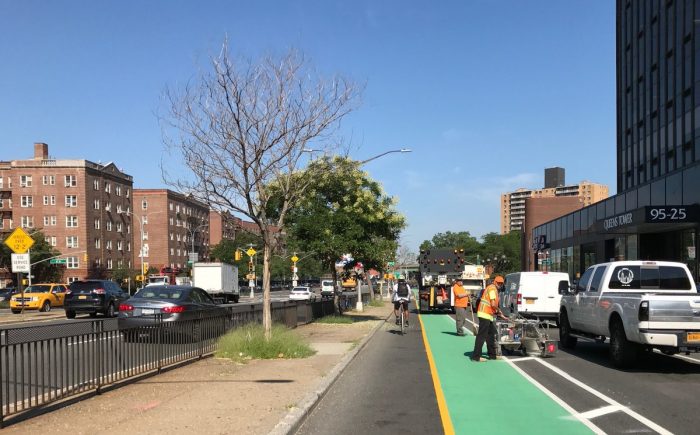
Dec. 21, 2017 By Tara Law
The Department of Transportation announced Tuesday that it had installed more than 25 miles of bike lanes in 2017—a record year.
The 25 miles broke last year’s record when 18 miles were installed, according to the DOT.
The city now has a bike lane network that is nearly 1,200 miles with more than 80 miles of that network being on-street protected bike lanes. Most of the network consists of painted lines.
Many Queens residents have praised the City’s investment in protected bike lanes as a way to make the streets safer, and to improve transportation as streets have become more congested and the subways slower.
Transportation Alternatives, an advocacy group seeking safer streets and bicycle lanes, has been a prominent voice in favor of the additions. Paul Steely White, the organization’s executive director, praised the DOT’s efforts.
“We look forward to working with the Department of Transportation not only to secure a year-over-year expansion of this life-saving infrastructure, but to ensure that one day soon every New Yorker will live within a quarter-mile of a protected bike lane,” said White.
DOT Commissioner Polly Trottenberg discussed the strides the city has made to expand cycling.
“Twenty years ago, the city took a big step forward with its first plan to build a bike lane network, and cycling is now growing by orders of magnitude, faster than any other mode of transportation in the city,” said Trottenberg.
Not all New Yorkers have welcomed the protected bike lanes so enthusiastically.
Project opponents in Queens have contended that it is more difficult for drivers to navigate streets narrowed by the lanes. Some business owners have also complained that the elimination of parking spaces to make way for the protected bike lanes has cut down on their flow of customers.
Despite these objections, the DOT has moved forward with its plans last year, including three major projects in Queens.
The DOT installed Phase 3 of the Queens Boulevard transformation, which resulted in protected bicycle lanes being installed between Eliot Avenue and Yellowstone Boulevard as part of the ongoing project. The redesign resulted in the loss of 198 parking spaces.
A bike lane on 111th Street by Flushing Meadows Corona Park in Corona was installed this year.
Finally, by Alley Pond Park in Bayside, several miles of protected bike lanes connect Joe Michaels Mile to Douglaston via Northern Boulevard.

DOT
13 Comments

The bike lanes up and down Queens Blvd. are a hazard. One lane for cars, buses, cabs, trucks and other vehicles who pay NYS for registration, inspection and insurance to make a lane for people who DON’T pay for those things and go through red lights and stop signs is insane and an accident waiting to happen!
Bikes don’t belong on busy streets
This is such great news! There should be protected bike lanes on every street in Sunnyside!
While the city officially blames Uber and Lyft for slowing down traffic, anyone with half a brain knows the real culprit is all of these stupid (and hardly-used) bike lanes all over the place. They take away auto lanes and parking spaces, while increasing congestion for drivers, cyclists, and pedestrians. You CANNOT reverse-engineer the city to make it “bicycle friendly.” End this nonsense now, DiBlasio!
The bike lanes in Rego Park are used by ambulances for parking between calls, trucks for deliveries, cars for bypassing trucks and cars double parked in the single traffic lane, motorized delivery bikes and skate boarders. Just a handful of bikers use the lanes. And when they do the majority do not stop at traffic lights nor yield to pedestrians. It is not enough for the DOT to pat itself on the back for building the lanes. Trottenberg and company must ENFORCE the traffic laws for motor vehicles AND bikers.
Get lost
Why am I not surprised that after cancelling a meeting to meet opponents of bike lanes running through residential streets that the DOT issues a press release praising themselves on the same issue? How many more dog and pony shows will they put on before they declare themselves ready to meet us? Their dishonesty would be appalling in a person but because they are an agency they think they don’t accrue moral demerits. Wrong.
Glad Sunnyside the streets are too narrow to have bike lanes because i’ve noticed most of my neighbors have to use their car to get to work, buses and subways are not as easy to get to late at night or very early in the morning or especially on sunday
Lots of Sunnyside streets have bike lanes.
Most streets are wide enough where you wouldn’t even lose a lane or parking when you add protected bike lanes. The more narrow lanes have the added benefit of making cars drive slower (which makes the street safer).
Glad to see New York is catching up with the rest of the cities in the US.
So why did you move here?
Lots of good reasons to live in New York. Glad to see improvements as well.